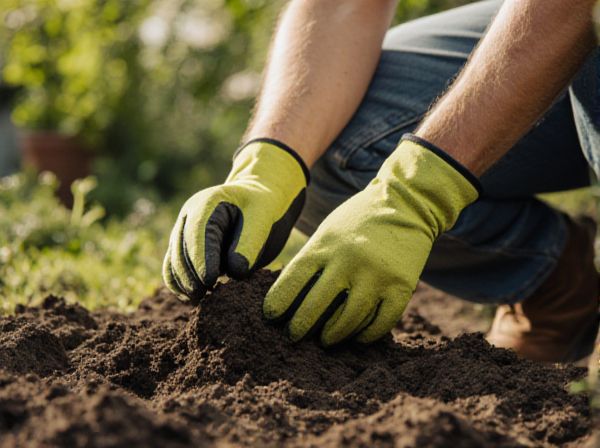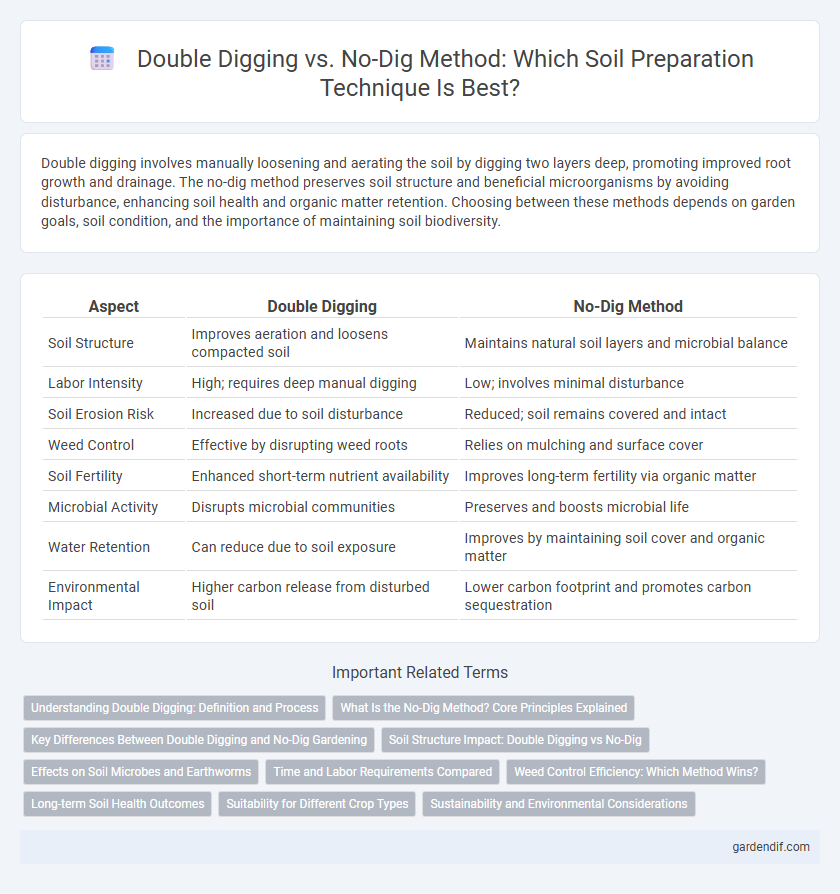
Double digging vs No-dig method Illustration
Double digging involves manually loosening and aerating the soil by digging two layers deep, promoting improved root growth and drainage. The no-dig method preserves soil structure and beneficial microorganisms by avoiding disturbance, enhancing soil health and organic matter retention. Choosing between these methods depends on garden goals, soil condition, and the importance of maintaining soil biodiversity.
Table of Comparison
| Aspect | Double Digging | No-Dig Method |
|---|---|---|
| Soil Structure | Improves aeration and loosens compacted soil | Maintains natural soil layers and microbial balance |
| Labor Intensity | High; requires deep manual digging | Low; involves minimal disturbance |
| Soil Erosion Risk | Increased due to soil disturbance | Reduced; soil remains covered and intact |
| Weed Control | Effective by disrupting weed roots | Relies on mulching and surface cover |
| Soil Fertility | Enhanced short-term nutrient availability | Improves long-term fertility via organic matter |
| Microbial Activity | Disrupts microbial communities | Preserves and boosts microbial life |
| Water Retention | Can reduce due to soil exposure | Improves by maintaining soil cover and organic matter |
| Environmental Impact | Higher carbon release from disturbed soil | Lower carbon footprint and promotes carbon sequestration |
Understanding Double Digging: Definition and Process
Double digging is a traditional soil preparation technique involving the removal and loosening of two layers of soil to enhance aeration and root penetration. This method typically requires digging down about 12 to 18 inches, turning over the soil, and integrating organic matter like compost to improve fertility and structure. By breaking up compacted layers, double digging promotes better drainage and stimulates beneficial microbial activity compared to surface-level cultivation.
What Is the No-Dig Method? Core Principles Explained
The no-dig method involves cultivating soil without disturbing its natural structure by avoiding traditional digging or turning. It relies on layering organic matter on the surface to enhance soil fertility, promote microbial activity, and improve moisture retention. This approach supports soil health by preserving beneficial organisms and preventing erosion, resulting in sustainable and productive gardening.
Key Differences Between Double Digging and No-Dig Gardening
Double digging involves manually loosening two layers of soil to improve aeration and root penetration, while the no-dig method preserves soil structure by minimizing disturbance and relying on organic mulch to enhance fertility. Double digging accelerates nutrient incorporation but can disrupt soil microorganisms, whereas no-dig gardening promotes microbial diversity and long-term soil health. Choosing between these methods depends on soil condition, labor availability, and desired maintenance intensity.
Soil Structure Impact: Double Digging vs No-Dig
Double digging significantly improves soil structure by loosening compacted layers, enhancing aeration, and promoting deep root growth, which accelerates nutrient cycling. In contrast, the no-dig method preserves soil aggregates and existing microbial networks, maintaining natural soil porosity and reducing erosion. Both methods influence soil health differently, with double digging altering the soil profile more aggressively, while no-dig supports long-term soil stability and biodiversity.
Effects on Soil Microbes and Earthworms
Double digging aerates soil by loosening deeper layers, promoting oxygen flow and microbial activity, which enhances nutrient cycling and earthworm proliferation. In contrast, the no-dig method maintains soil structure, preserving earthworm habitats and fostering a stable microbial community by minimizing disturbance. Both techniques influence soil biodiversity differently, with double digging accelerating biological turnover while no-dig supports long-term ecosystem resilience.
Time and Labor Requirements Compared
Double digging requires significant time and intense labor as it involves deep manual soil turning and amendment incorporation over multiple hours per square meter. The no-dig method drastically reduces physical effort and time commitments by maintaining soil structure and applying organic mulch without disturbing the soil layers. Gardeners adopting no-dig often benefit from increased efficiency and reduced fatigue while still promoting healthy soil ecosystems.
Weed Control Efficiency: Which Method Wins?
Double digging disrupts weed roots deeply, reducing weed proliferation by aerating soil and burying weed seeds effectively. In contrast, the no-dig method suppresses weeds primarily through mulch layers and minimal soil disturbance, promoting beneficial microbial activity that inhibits weed growth. Studies show double digging offers more immediate weed control, while no-dig provides sustainable weed suppression over time.
Long-term Soil Health Outcomes
Double digging improves soil aeration and root penetration by loosening deep layers, promoting immediate nutrient availability but can disrupt soil structure and microbial communities over time. The no-dig method preserves soil aggregates and enhances organic matter retention, supporting stable microbial ecosystems and improved water infiltration in the long term. Studies show no-dig practices increase soil carbon sequestration and biodiversity, leading to more resilient and sustainable soil health outcomes compared to frequent mechanical disturbance.
Suitability for Different Crop Types
Double digging is ideal for root vegetables like carrots and potatoes, as it improves soil aeration and root penetration, while the no-dig method better suits shallow-rooted crops such as leafy greens and herbs by preserving soil structure and microbial life. Deeply rooted plants benefit from the thorough loosening provided by double digging, promoting healthy growth, whereas no-dig gardening maintains soil ecosystems that support nutrient cycling essential for surface crops. Selecting between double digging and no-dig methods depends on crop root depth and soil disturbance tolerance for optimal yield and soil health.
Sustainability and Environmental Considerations
Double digging enhances soil aeration and nutrient penetration but can disrupt soil microorganisms and lead to increased erosion and carbon release. The no-dig method preserves soil structure and biodiversity by minimizing disturbance, promoting long-term soil health and carbon sequestration. Sustainable gardening practices favor no-dig techniques to maintain soil integrity and reduce environmental impact.
Double digging vs No-dig method Infographic

 gardendif.com
gardendif.com